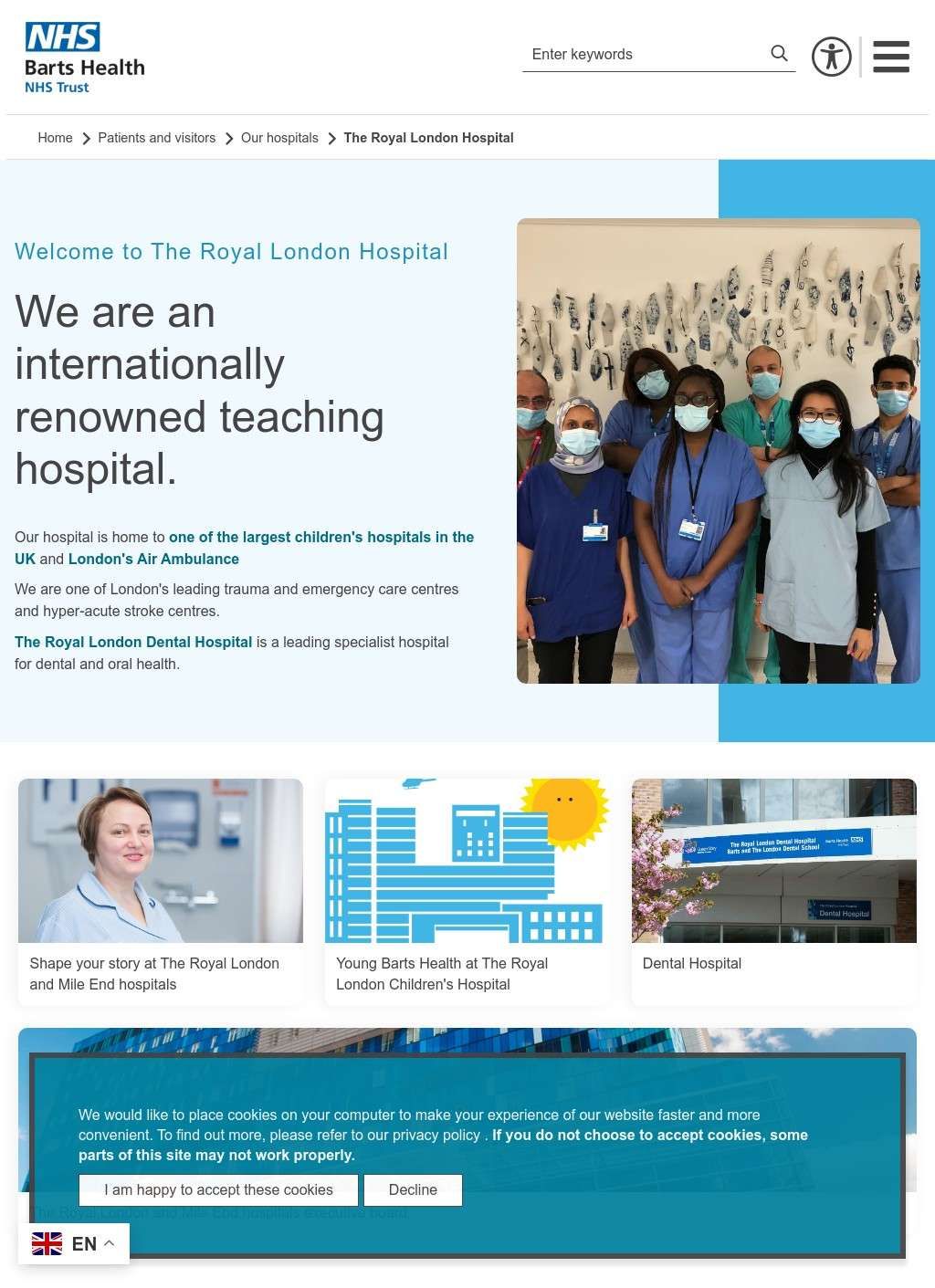The Royal London Hospital operates as a cornerstone of healthcare provision in East London, serving the City of London and Tower Hamlets with comprehensive medical services. Part of Barts Health NHS Trust, this teaching hospital combines centuries of medical tradition with cutting-edge facilities, having undergone major redevelopment completed in 2012. The institution manages one of Europe's largest emergency departments and serves as the capital's leading trauma center, with London's Air Ambulance based on its roof. This positioning makes it crucial for managing major incidents and complex medical emergencies across the capital.
Historical foundations date back to 1740 when seven gentlemen met in a Cheapside tavern to establish what became the London Infirmary. The institution moved through several locations before settling at its current Whitechapel site in 1757, where it has continuously served London's East End through dramatic social and demographic changes. Queen Elizabeth II added "Royal" to the hospital's name in 1990, marking its 250th anniversary. This long history provides deep roots in the local community while the modern facilities enable delivery of 21st-century healthcare.
The trauma center designation places The Royal London at the apex of emergency care provision in the capital. As part of the London Trauma System established in 2010, the hospital receives the most severely injured patients from across London and beyond. Specialized teams available round-the-clock include neurosurgeons, cardiothoracic surgeons, and interventional radiologists, enabling treatment of injuries that would prove fatal without immediate expert intervention. The helipad facilitates rapid patient transfer, with London's Air Ambulance delivering critical cases directly to the hospital's emergency department.
Children's services represent another major specialty, with one of the UK's largest pediatric hospitals integrated within the broader hospital complex. The children's emergency department handles tens of thousands of cases annually, from minor injuries to complex medical conditions requiring specialist intervention. Dedicated pediatric intensive care units, surgical theaters, and specialist wards ensure young patients receive age-appropriate care in child-friendly environments. The dental hospital, also part of the complex, provides comprehensive pediatric dental services alongside adult care.
Medical education forms an integral part of The Royal London's mission through its association with Barts and The London School of Medicine and Dentistry, part of Queen Mary University of London. Medical students undergo clinical training across the hospital's departments, learning from experienced clinicians while contributing to patient care under supervision. The Centre for Trauma Sciences conducts world-leading research into injury treatment and prevention, with findings directly improving patient outcomes. This academic integration ensures the hospital remains at the forefront of medical advancement.
Specialist services extend across numerous medical disciplines, drawing patients from well beyond the local catchment area. The renal unit ranks among Europe's largest, providing dialysis and transplant services to patients with kidney disease. Cardiology departments offer everything from routine cardiac care to complex interventional procedures. Cancer services integrate with those at St Bartholomew's Hospital, another Barts Health facility, ensuring comprehensive oncology care. These specialties operate alongside general medical and surgical services that meet the routine healthcare needs of local residents.
The emergency department experiences constant pressure, typical of inner London hospitals serving diverse populations with complex health needs. Despite handling over 150,000 attendances annually, teams strive to maintain quality care and reasonable waiting times. Triage systems prioritize patients based on clinical need, with separate areas for major trauma, resuscitation, and minor injuries. Integration with community services helps manage demand by providing alternatives to emergency attendance where appropriate, though population growth continues challenging capacity.
Staff across The Royal London represent the NHS's diversity, with healthcare professionals from numerous countries bringing varied expertise and cultural understanding. Nursing teams form the backbone of patient care, working in specialties from intensive care to community liaison. Allied health professionals including physiotherapists, occupational therapists, and speech therapists contribute to holistic patient treatment. Support staff in roles from portering to administration ensure smooth hospital operations, often going beyond job descriptions to assist patients and families during difficult times.
Facilities upgraded during the major redevelopment provide modern environments for both treatment and recovery. Ward designs prioritize natural light and patient privacy while enabling efficient clinical care. State-of-the-art operating theaters incorporate the latest surgical technologies, from robotic systems to advanced imaging equipment. Diagnostic facilities including MRI and CT scanners operate extended hours to minimize waiting times. These physical improvements significantly enhance patient experience compared to the older buildings they replaced.
Community engagement reflects The Royal London's position serving some of London's most diverse neighborhoods. Outreach programs work with local communities to improve health awareness and access to services. Volunteer programs bring community members into the hospital, providing additional support for patients while strengthening local connections. The hospital's charity funds enhancements beyond core NHS provision, from artwork improving environments to equipment enabling innovative treatments. These initiatives help maintain the institution's deep roots in East London communities.
Challenges facing The Royal London mirror those across the NHS, including funding constraints, increasing demand, and workforce pressures. The hospital's location in an area with significant deprivation means many patients present with complex health needs requiring intensive support. Language barriers and cultural differences require sensitive handling to ensure equitable care delivery. Despite these pressures, quality indicators generally show good performance, with recent Care Quality Commission inspections rating services positively while identifying areas for continued improvement.
Future developments focus on maintaining The Royal London's position as a leading trauma and emergency center while enhancing local services for City of London and Tower Hamlets residents. Digital innovations promise improved efficiency and patient experience, from electronic health records to telemedicine options. Research activities continue expanding, with clinical trials offering patients access to novel treatments while advancing medical knowledge. Through ongoing evolution, The Royal London Hospital continues its nearly three-century mission of providing healthcare to Londoners, adapting to meet contemporary needs while honoring its historical legacy of service to all who need care, regardless of their ability to pay.
